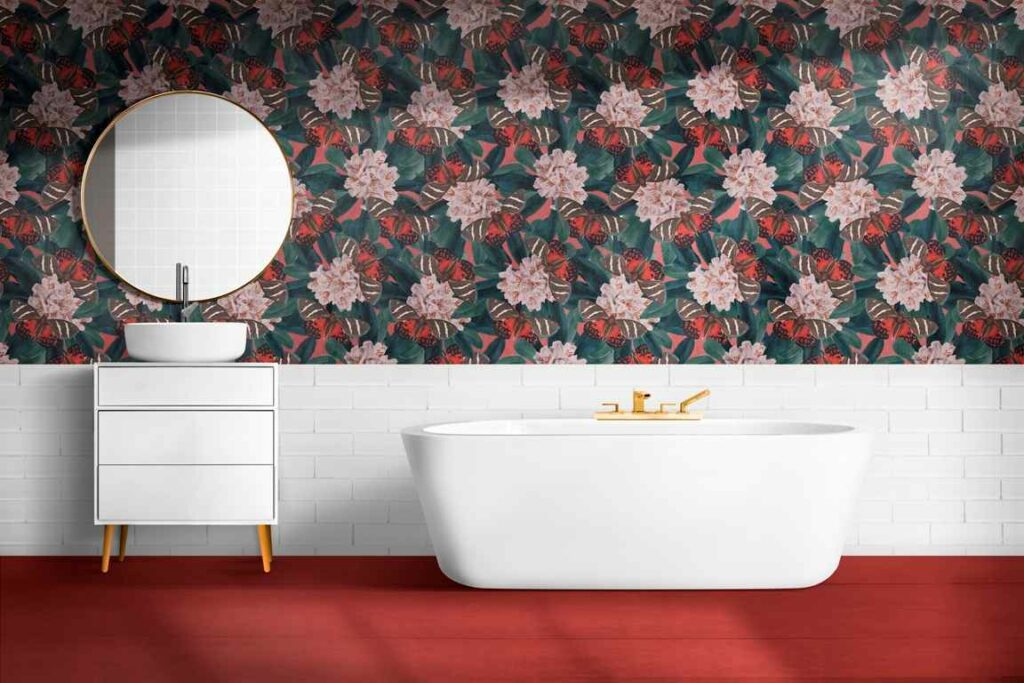Yes, you can put wallpaper in a bathroom.
However, it is essential to manage humidity, water, and heat to ensure the wallpaper’s longevity.
Avoid installing wallpaper in areas exposed to excessive splashings, such as the shower area.
It is more feasible to use wallpaper in a half bath with only a sink and toilet or as an accent wall in a full bathroom, away from the tub or shower.
Proper installation and maintenance can help reduce potential issues with wallpaper in a bathroom.
What Are Some Specific Measures To Manage Humidity And Water In A Bathroom When Using Wallpaper?
Here are some specific measures to manage humidity and water in a bathroom when using wallpaper:
- Install a high-velocity bathroom exhaust fan to reduce bathroom humidity
- Purchase an external dehumidifier to extract excess moisture from the air
- Apply a clear acrylic varnish over the installed wallpaper to boost its resistance to moisture and heat
- Use vinyl wallpapers that are more commonly used in bathrooms, especially if they are to be used in an area where they may get splashed
- Leave the bathroom door and/or windows open during and after bathing to let the steam escape whenever possible
- Dust your wallpaper on a weekly or biweekly basis to maintain it
Are There Any Types Of Wallpaper That Are More Suitable For Bathroom Installations Than Others?
Yes, there are types of wallpaper that are more suitable for bathroom installations than others.
It is recommended to choose solid vinyl, fabric-backed vinyl, or paper-backed vinyl wallpaper as they are scrubbable and stripped.
Additionally, it is important to choose a wallpaper that is mould-proof and to apply a mould-proof wallpaper primer to the wall before installation.
Some examples of bathroom wallpapers include Tempaper’s Feather Flock Chalk, which is budget-friendly and features a neutral swan pattern, and bold, textured wallpapers like black mock-snakeskin wallpaper, which adds drama and bounces light around the room.

Can You Provide Tips On Properly Installing Wallpaper In A Bathroom To Ensure Its Longevity?
Here are some tips for properly installing wallpaper in a bathroom to ensure its longevity:
- Measure ahead of time and start with a blank slate by removing all hardware hanging on the walls
- Clean and prime the walls before installation
- Use a clear acrylic varnish over the installed wallpaper to boost its resistance to moisture and heat
- Avoid applying wallpaper to porous or textured walls, unpainted drywall or plaster, or high-gloss paint
- Start with a smooth, flat surface
- Use the right tools, including spackle or patching plaster, putty knife, drywall sanding block, pre-pasted wallpaper, wallpaper primer, 3/8″ nap paint roller, 2-1/2″ sash brush, step stool, paint tray (and optional liner), 3′- 4′ spirit level, measuring tape, clear quilting ruler or square, pencil, scissors, plastic tub (or bathtub), water, and metal straight edge
How Often Should Wallpaper In A Bathroom Be Inspected And Maintained To Prevent Any Issues?
There is no specific frequency for inspecting and maintaining wallpaper in a bathroom.
However, it is recommended to use solid vinyl, fabric-backed vinyl, or paper-backed vinyl wallpaper, which are scrubbable and stripped, and to apply a mould-proof wallpaper primer to the wall before installation.
To clean wallpaper in a bathroom, use a soft, non-abrasive cloth and mild dish soap or castile soap.
Before installing wallpaper in a bathroom, ensure that the walls are clean and primed, and patch all holes.
Once everything has dried, opt for a primer that is specific to your space.
It is also important to avoid heavy rubbing when cleaning textured vinyl wallpaper, as it can smooth out the dimensional features.
Are There Any Alternative Wall Coverings Or Materials That Are More Recommended For High-Moisture Areas Like Bathrooms?
Yes, there are alternative wall coverings or materials that are more recommended for high-moisture areas like bathrooms.
Some of the recommended options include:
- Stone veneer with a sealant
- Open-cell foam or closed-cell spray foam
- PVC 3D wall panels
- Beadboard with semi-gloss or glossy paint
- PVC wall panels like Trusscore Wall&CeilingBoard and Trusscore Slatwall







